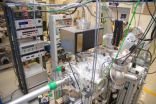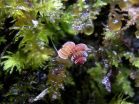Don't forget F-type stars in search for life, UT Arlington researchers say
2014-03-25
(Press-News.org) Scientists searching for habitable planets beyond Earth shouldn't overlook F-type stars in favor of their more abundant, smaller and cooler cousins, according to new research from University of Texas at Arlington physicists.
Stars fall into seven lettered categories according to their surface temperature, but they also differ in other factors such as mass, luminosity and abundance in the universe. Scientists looking for habitable planets typically have focused on the less massive end of the spectrum, where our own G-type sun as well as the even less massive K and M-type stars reside.
F-types are the in the middle of the scale, more massive and hotter than our Sun. Their increased ultraviolet radiation has been thought to be a limiting factor for sustaining life. In addition, there just aren't as many of them.
But, UT Arlington Physics Professor Manfred Cuntz, contends: "F-type stars are not hopeless."
Cuntz said: "There is a gap in attention from the scientific community when it comes to knowledge about F-type stars, and that is what our research is working to fill. It appears they may indeed be a good place to look for habitable planets."
Cuntz and UT Arlington Ph.D. student Satoko Sato teamed with researchers from the University of Guanajuato in Mexico for a new work published this week by the International Journal of Astrobiology. They argue that since F-type stars have a wider habitability zone – the area where conditions are right for general Earth-type planets to develop and sustain life – they warrant additional consideration.
The researchers also explored the potential limitations caused by UV radiation by estimating the potential damage that carbon-based macromolecules necessary for life would sustain in F-type stars' habitable zones. To do that, they used DNA as an example and compared estimates of DNA damage on planets in F-type star systems to the damage that would be done on Earth by the sun.
The research included calculations for several different types of F-type stars, at different points in their evolution. It found encouraging results. In a few cases, the damage estimates were similar to the damage on Earth, if Earth did not have an atmosphere. The damage estimate was even less if an atmosphere on the planet in the F-type system was assumed.
"Our study is a further contribution toward the exploration of the exobiological suitability of stars hotter and, by implication, more massive than the Sun … at least in the outer portions of F-star habitable zones, UV radiation should not be viewed as an insurmountable hindrance to the existence and evolution of life," the study said.
The study is called "Habitability around F-type Stars" and is available online here: http://journals.cambridge.org/action/displayIssue?jid=IJA&tab=firstview. Co-authors from the University of Guanajuato were Cecilia Maria Guerra Olvera, Dennis Jack and Klaus-Peter Schröder.
Pamela Jansma, dean of the UT Arlington College of Science, said the collaboration between Sato and Cuntz is representative of the research advances that can result from a strong faculty-graduate student mentorship.
"Astrophysics as it relates to habitable planets is an increasingly popular topic, and Dr. Cuntz and his student have enriched that conversation by weaving elements of theoretical biology and planetary science into their outstanding work," Jansma said.
The new paper suggests that further research be done that would include detailed chemical models of planetary atmospheres, examples of specific star-planet systems with observational data and cases of F-type stars that are members of binary or higher-order systems.INFORMATION:
About UT Arlington
The University of Texas at Arlington is a comprehensive research institution and the second largest institution in The University of Texas System. The Chronicle of Higher Education ranked UT Arlington as the seventh fastest-growing public research university in 2013. U.S. News & World Report ranks UT Arlington fifth in the nation for undergraduate diversity. Visit http://www.uta.edu to learn more. Follow #UTAdna on Twitter.
ELSE PRESS RELEASES FROM THIS DATE:
Model now capable of street-level storm-tide predictions
2014-03-25
The water that surged into the intersection of New York City's Canal and Hudson streets during Hurricane Sandy—to choose just one flood-ravaged locale—was ultimately driven ashore by forces swirling hundreds of miles out in the Atlantic.
That simple fact shows not only the scale and power of a tropical cyclone, but the difficulty of modeling and forecasting its potential for coastal flooding on the fine scale needed to most effectively prepare a response.
Now, a study led by Professor Harry Wang of William & Mary's Virginia Institute of Marine Science demonstrates the ...
Indian women with more resources than their husbands face heightened risk of violence
2014-03-25
NEW YORK (25 March 2014) — A new study has found that women in India who have more education than their husbands, who earn more, or who are the sole earners in their families have a higher likelihood of experiencing frequent and severe intimate partner violence (IPV) than women who are not employed or who are less educated than their spouse.
There are two existing theories that aim to predict what happens when a woman has status and resources that are equal to or greater than her husband's. One theory, called bargaining theory, posits that a woman who has more relative ...
How to look into the Solar interior
2014-03-25
An international group including one professor from the Moscow State University proposed the first ever quantitative description of the mechanism responsible for sunspot formation and underlying the Solar activity cycle.
Magnetic field helicity is one of the so-called motion invariants in magneto-hydrodynamics. It is a conserved quantity, like energy, describing the degree to which the field lines are "wrapped around themselves". During the last 20 years, scientists realized that conservation of this quantity is even more influential upon magnetic field evolution than ...
Micro systems with big commercial potential featured in SPIE journal
2014-03-25
BELLINGHAM, Washington, USA — Commercial demand is driving high-tech research and development in micro-opto-electro-mechanical systems (MOEMS) for diverse applications such as space exploration, wireless systems, and healthcare. A new special section on Emerging MOEMS Technology and Applications in the current issue of the Journal of Micro/Nanolithography, MEMS, and MOEMS (JM3) gathers recent breakthrough achievements and explains how such innovations in the photonics field are poised to emerge in the marketplace. The journal is published by SPIE, the international society ...
Mars-mimicking chamber explores habitability of other planets
2014-03-25
WASHINGTON D.C., March 25, 2014 -- A research team in Spain has the enviable job of testing out new electromechanical gear for potential use in future missions to the "Red Planet." They do it within their Mars environmental simulation chamber, which is specially designed to mimic conditions on the fourth planet from the sun -- right down to its infamous Martian dust.
Mars is a key target for future space exploration, thanks to indications that the planet may have either been capable of supporting life in the past or is possibly even supporting it right now within its ...
Malaysian microjewels going extinct as they are discovered
2014-03-25
A Malaysian-Dutch team of biologists have catalogued all 31 species of the tiny, but oh so pretty snail genus Plectostoma from West-Malaysia, Sumatra, and Thailand. Ten species are new to science, but some of those are going extinct as they are being discovered.
The study was carried out by PhD student Thor-Seng Liew of Naturalis Biodiversity Center in Leiden, The Netherlands, and three colleagues. Liew, who is on study leave from Universiti Malaysia Sabah, spent four years studying the distribution, shell shape, and genetics of these minuscule snails. He is still working ...
First stem cell study of bipolar disorder yields promising results
2014-03-25
ANN ARBOR, Mich. — What makes a person bipolar, prone to manic highs and deep, depressed lows? Why does bipolar disorder run so strongly in families, even though no single gene is to blame? And why is it so hard to find new treatments for a condition that affects 200 million people worldwide?
New stem cell research published by scientists from the University of Michigan Medical School, and fueled by the Heinz C. Prechter Bipolar Research Fund, may help scientists find answers to these questions.
The team used skin from people with bipolar disorder to derive the first-ever ...
Fewer children at risk for deficient vitamin D
2014-03-25
MAYWOOD, Il. – Under new guidelines from the Institute of Medicine, the estimated number of children who are at risk for having insufficient or deficient levels of vitamin D is drastically reduced from previous estimates, according to a Loyola University Chicago Stritch School of Medicine study.
The study, led by Holly Kramer, MD, MPH and Ramon Durazo-Arvizu, PhD, is published online ahead of print in the Journal of Pediatric Endocrinology and Metabolism.
New Institute of Medicine guidelines say most people get sufficient vitamin D when their blood levels are at or ...
Black markets for hackers are increasingly sophisticated, specialized and maturing
2014-03-25
Black and gray markets for computer hacking tools, services and byproducts such as stolen credit card numbers continue to expand, creating an increasing threat to businesses, governments and individuals, according to a new RAND Corporation study.
One dramatic example is the December 2013 breach of retail giant Target, in which data from approximately 40 million credit cards and 70 million user accounts was hijacked. Within days, that data appeared -- available for purchase -- on black market websites.
"Hacking used to be an activity that was mainly carried out by individuals ...
Lick's new Automated Planet Finder: First robotic telescope for planet hunters
2014-03-25
Lick Observatory's newest telescope, the Automated Planet Finder (APF), has been operating robotically night after night on Mt. Hamilton since January, searching nearby stars for Earth-sized planets. Every night the fully autonomous system checks the weather, decides which stars to observe, and moves the telescope from star to star throughout the night, collecting measurements that will reveal the presence of planets. Its technical performance has been outstanding, making it not only the first robotic planet-finding facility but also one of the most sensitive.
The search ...





